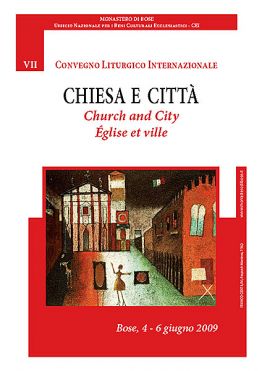Research project and scientific committee
VII International Liturgical Conference
CHURCH AND CITY
Monastery of Bose
National Office for the Church's Cultural Heritage of the Italian Bishops' Conference
 RESEARCH PROJECT AND SCIENTIFIC COMMITTEE
RESEARCH PROJECT AND SCIENTIFIC COMMITTEE
The Church was born and grew in the city, so that it became the Church of one city. It is bound to a city to such an extent that every local Church has always borne the name of the city or town in which the Christians came together in assembly: the Church of God that is in Jerusalem, in Corinth, in Rome… Even when Christianity progressively spread to the villages, to the countryside, and to the mountains from one end of the earth to the other, there has never been a Church without its city or town of origin. At the beginning of the third millennium the dialogue between Church and city, a fundamental form of the relation between Church and society, is changing, it is becoming more and more intense and seems destined to become more complex and diverse than in the past. City populations are progressively growing all over the world, in different forms on each continent. Cities become populated for good by new citizens who arrive from other parts of the same country, but not only, forced to move by poverty. Especially in Europe other men and women arrive from distant lands and settle more or less stably, forming clusters of multiform communities.
The Church, thus, shares the fate of those it welcomes in the peripheries and in abandoned centers of cities, it identifies itself with the new citizens who arrive, driven by the need of bread and of a place to live; it recognizes itself in all who travel and come to the world’s cities for work, study, tourism. This is a challenge than can be expressed in two simple questions: is the city of the future destined to see the triumph of a social life secularized to the point of becoming a shapeless mass of undifferentiated religious proposals? How can it be possible to announce, celebrate, live as Christians in the cities and metropolises disseminated over the face of the earth? Especially in the cities the Church perceives great transformations taking place, discovers the plurality of communities and of religions, and realizes what it means to live a change that is at the same time global and local. Today the Church, hence, is called not to undergo the change taking place, but to interpret it, accompany it, evaluate it critically, inviting also political authorities and persons involved in culture to reflection and intelligent action.
This social and church context is the background and horizon to the VII International Liturgical Conference of Bose, which will treat from the anthropological, sociological, historical, liturgical, theological, architectural, and city-planning viewpoints the theme of Church and city. Churches are a metaphor of the presence of the Church in the city of man, since the Church shows itself publicly and is represented in its churches, which are a high and other form of language. Strewn over the urban fabric, on squares or along the streets, churches are images at the same time of the proximity and of the otherness of that of which they are a sign. The more they are places of beauty the more they testify to an ethos that inspires and molds good relations and good human ties. They reveal the style of the presence of Christians in society, which is always both nearness in difference and presence in service. The facade of a church is the face of the Church, which in nearness to men says welcome, gratuitous gift, sharing, and consolation. If churches are this, they are the sacrament of God’s presence among men. Every human being, believer or not, will be able to recognize together with the liturgy: “Locus iste a Deo factus est, inaestimabile sacramentum” (4Esd 8, 21), “this place has been made by God, it is a sacrament that surpasses all price”.
These are the questions that will be the basis for the conference’s reflections: How to celebrate today in cities so rich in novelty? How to design new churches in cities intensely marked by mobility, by many cultures, and by the presence of many confessions and religions? How best to utilize, in response to today’s challenges, the patrimony of churches and of church buildings inherited from history? What churches still preserve and even increase their significance in the historical city centers of Europe? What can be the role of cathedrals in ancient cities? What does it mean to design, build, and celebrate in countries and cities where Christians are a minority?
To seek simple and serious answers to these difficult questions is already to design and build churches and with them to build up the Church of God in the midst of the City of men.
Scientific committee: ENZO BIANCHI (Bose), STEFANO RUSSO (Roma), GOFFREDO BOSELLI (Bose), FRÉDÉRIC DEBUYST (Louvain-la-Neuve), PAUL DE CLERCK (Paris - Brussel), ALBERT GERHARDS (Bonn), ANGELO LAMERI (Roma), KEITH PECKLERS (New York - Roma), GIANCARLO SANTI (Milano).